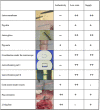Microsurgical training course for clinicians and scientists: a 10-year experience at the Münster University Hospital
- PMID: 34024279
- PMCID: PMC8142514
- DOI: 10.1186/s12909-021-02737-1
Microsurgical training course for clinicians and scientists: a 10-year experience at the Münster University Hospital
Abstract
Background: Microsurgical techniques are an important part of clinical and experimental research. Here we present our step-by-step microsurgery training course developed at the Münster University Hospital. The goal of this course was to create a short, modular curriculum with clearly described and easy to follow working steps in accordance with the Guidelines for Training in Surgical Research in Animals by the Academy of Surgical Research.
Methods: Over the course of 10 years, we conducted an annual 2.5 day (20 h) microsurgical training course with a total of 120 participants.
Results: Prior to the course, 90% of the participants reported to have never performed a microanastomosis before. During the 10 years a total of 84.2% of the participants performed microanastomoses without assistance, 15% required assistance and only 0.8% failed.
Conclusions: Our step-by-step microsurgery training course gives a brief overview of the didactic basics and the organization of a microsurgical training course and could serve as a guide for teaching microsurgical skills. During the 2.5-day curriculum, it was possible to teach, and for participants to subsequently perform a microsurgical anastomosis. The independent reproducibility of the learned material after the course is not yet known, therefore further investigations are necessary. With this step-by-step curriculum, we were able to conduct a successful training program, shown by the fact that each participant is able to perform microvascular anastomoses on a reproducible basis.
Keywords: Anastomosis; Curricular training; Microsurgery; Microsurgical training; Training; Vascular anastomosis.
Conflict of interest statement
The authors declare that they have no competing interests.
Figures





Similar articles
-
Development and evaluation of a surgical skills lab for trainee surgeons: a 10-year experience at the Münster University Hospital.BMC Med Educ. 2025 Apr 4;25(1):484. doi: 10.1186/s12909-025-07064-3. BMC Med Educ. 2025. PMID: 40186239 Free PMC article.
-
Microsurgical training course for clinicians and scientists at a German University hospital: a 10-year experience.Microsurgery. 2003;23(5):461-5. doi: 10.1002/micr.10180. Microsurgery. 2003. PMID: 14558003
-
Microvascular training of medical students and surgeons - a comparative prospective study.J Craniomaxillofac Surg. 2013 Dec;41(8):e187-90. doi: 10.1016/j.jcms.2013.01.017. Epub 2013 Feb 9. J Craniomaxillofac Surg. 2013. PMID: 23402732
-
Effectiveness of a microvascular surgery training curriculum for orthopaedic surgery residents.J Bone Joint Surg Am. 2015 Jun 3;97(11):950-5. doi: 10.2106/JBJS.N.00854. J Bone Joint Surg Am. 2015. PMID: 26041858 Review.
-
Defining Standards in Experimental Microsurgical Training: Recommendations of the European Society for Surgical Research (ESSR) and the International Society for Experimental Microsurgery (ISEM).Eur Surg Res. 2017;58(5-6):246-262. doi: 10.1159/000479005. Epub 2017 Jul 26. Eur Surg Res. 2017. PMID: 28746936 Review.
Cited by
-
Development and evaluation of a surgical skills lab for trainee surgeons: a 10-year experience at the Münster University Hospital.BMC Med Educ. 2025 Apr 4;25(1):484. doi: 10.1186/s12909-025-07064-3. BMC Med Educ. 2025. PMID: 40186239 Free PMC article.
-
Enhancing microsurgical skills in neurosurgery residents of low-income countries: A comprehensive guide.Surg Neurol Int. 2023 Dec 22;14:437. doi: 10.25259/SNI_791_2023. eCollection 2023. Surg Neurol Int. 2023. PMID: 38213434 Free PMC article.
-
Incentive policy for the comprehensive development of young medical talents: an evolutionary game study.Front Public Health. 2024 Feb 2;12:1325166. doi: 10.3389/fpubh.2024.1325166. eCollection 2024. Front Public Health. 2024. PMID: 38371237 Free PMC article.
References
-
- Chen Z, Kebschull L, Foll DA, Rauen U, Hansen U, Heitplatz B, et al. A novel histidine-tryptophan-ketoglutarate formulation ameliorates intestinal injury in a cold storage and ex vivo warm oxygenated reperfusion model in rats. Biosci Rep. 2020;40(5):BSR20191989. doi: 10.1042/BSR20191989. - DOI - PMC - PubMed
-
- Becker F, Romero E, Goetzmann J, Hasselschwert DL, Dray B, Vanchiere J, et al. Endogenous specialized Proresolving mediator profiles in a novel experimental model of lymphatic obstruction and intestinal inflammation in African Green monkeys. Am J Pathol. 2019;189(10):1953–1972. doi: 10.1016/j.ajpath.2019.05.013. - DOI - PMC - PubMed
MeSH terms
LinkOut - more resources
Full Text Sources
Other Literature Sources

